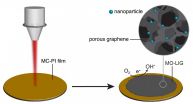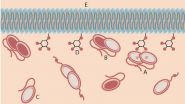(Press-News.org) Medicaid is expected to save billions of dollars a year as patents for several blockbuster antipsychotic medications expire and use of generic versions of these drugs increases, according to a new study by researchers at the University of Maryland School of Medicine. These savings may provide relief from the high costs of these medications and allow policymakers to lift restrictions on patients' access, the researchers argue.
The study forecast that annual Medicaid payments for antipsychotic medicines will decrease by nearly $1.8 billion (or nearly 50 percent) by 2016 and by $2.8 billion (or 76 percent) by 2019. The forecasting models were developed by the authors, Eric Slade, PhD, an associate professor in the Department of Psychiatry and Linda Simoni-Wastila, BSPharm, MSPH, PhD, a professor at the University of Maryland School of Pharmacy. The study, the first to look at these possible cost savings, was published in the July issue of the journal Psychiatric Services.
The researchers predicted changes in overall Medicaid spending for antipsychotics between 2011 and 2019. In 2011, Medicaid spent more than $3.6 billion on second-generation antipsychotics. Five branded medications -- aripiprazole, quetiapine, olanzapine, ziprasidone, and paliperidone -- accounted for $3.3 billion or 90 percent of this spending. Medicaid is the major payer for antipsychotic medications in the U.S., accounting for between 70 percent and 80 percent of all antipsychotic prescriptions.
"Mental health medications are among the most prescribed drugs in Medicaid, and many of these medications have recently become available as generics or soon will be," said Dr. Slade, who is an economist. "Our predictions suggest that this change will result in a substantial financial windfall to states and to the federal government."
Antipsychotics are the mainstay of treatment for psychotic illnesses such as schizophrenia and bipolar disorder. In the 1990s, a new category of antipsychotic medications, known as "second generation antipsychotics," was introduced. These new medications promised fewer side effects, but they were also more expensive. Between 1999 and 2005, annual antipsychotic expenditures per Medicaid beneficiary more than doubled. By 2009, antipsychotics accounted for nearly 15 percent of all Medicaid expenditures for medications.
During the 1990's and 2000's, concerns about rising antipsychotic expenditures in Medicaid led many states to impose restrictions on the use of second-generation antipsychotics. Common Medicaid restrictions include requirements that a physician obtain prior authorization before writing a prescription, limits on the total number of prescriptions a patient can fill per month, and requirements to prescribe certain antipsychotics before trying others. Dr. Slade notes that as antipsychotic spending decreases, some of these limits may no longer be necessary.
"These findings have the potential to improve the lives of people suffering from schizophrenia and other mental disorders," said Bankole A. Johnson, MD, DSc, MB, ChB, chairman of the UM SOM psychiatry department. "As someone who treats patients I see firsthand how these diseases can cause suffering, and I hope this study can help alleviate some of that pain."
Patent protection for nearly all second generation antipsychotic medications, which include aripiprazole, asenapine, clozapine, iloperidone, lurasidone, olanzapine, paliperidone, quetiapine and ziprasidone, has expired or will expire within the next few years. Using data on antipsychotic prescriptions and spending in Medicaid, the researchers developed estimates of the savings to the Medicaid program from use of one drug, risperidone, during the years 2008 to 2011. Risperidone, one of the first second-generation drugs, became available generically in 2008. They then used these estimates to forecast savings for all antipsychotic medications.
"This study offers important information for policymakers as they navigate the difficulties of balancing fiscal responsibility with patients' needs," said Dean E. Albert Reece, MD, PhD, MBA, who is also the vice president for Medical Affairs, University of Maryland, and the John Z. and Akiko K. Bowers Distinguished Professor and Dean of the School of Medicine. "Dr. Slade's work is a great example of how the school is using data to make discoveries about health and health policy that have the potential to make a difference for patients."
Dean Reece and the Dean of the School of Pharmacy, Natalie D. Eddington, PhD, FCP, FAAPS, also praised the cooperation between UM SOM and the School of Pharmacy, saying that such cross-school integration often yields fruitful results. "This work by Dr. Slade and Dr. Simoni-Wastila shows how faculty from different disciplines, in different schools, can work together to bring their knowledge to bear on important questions, with novel, and useful, results," said Dean Eddington.
INFORMATION:
About the University of Maryland School of Medicine
The University of Maryland School of Medicine was chartered in 1807 and is the first public medical school in the United States and continues today as an innovative leader in accelerating innovation and discovery in medicine. The School of Medicine is the founding school of the University of Maryland and is an integral part of the 11-campus University System of Maryland. Located on the University of Maryland's Baltimore campus, the School of Medicine works closely with the University of Maryland Medical Center and Medical System to provide a research-intensive, academic and clinically based education. With 43 academic departments, centers and institutes and a faculty of more than 3,000 physicians and research scientists plus more than $400 million in extramural funding, the School is regarded as one of the leading biomedical research institutions in the U.S. with top-tier faculty and programs in cancer, brain science, surgery and transplantation, trauma and emergency medicine, vaccine development and human genomics, among other centers of excellence. The School is not only concerned with the health of the citizens of Maryland and the nation, but also has a global presence, with research and treatment facilities in more than 35 countries around the world.
medschool.umaryland.edu/
HOUSTON - (Aug. 20, 2015) - Rice University chemists who developed a unique form of graphene have found a way to embed metallic nanoparticles that turn the material into a useful catalyst for fuel cells and other applications.
Laser-induced graphene, created by the Rice lab of chemist James Tour last year, is a flexible film with a surface of porous graphene made by exposing a common plastic known as polyimide to a commercial laser-scribing beam. The researchers have now found a way to enhance the product with reactive metals.
The research appears this month in the ...
Leading scientists and experts in the field of rhino conservation state in a new paper that it is safe to consider the Sumatran rhinoceros extinct in the wild in Malaysia. The survival of the Sumatran rhino now depends on the 100 or fewer remaining individuals in the wild in Indonesia and the nine rhinos in captivity.
Despite intensive survey efforts, there have been no signs of the wild Sumatran rhinoceros (Dicerorhinus sumatrensis) in Malaysia since 2007, apart from two females that were captured for breeding purposes in 2011 and 2014. Scientists now consider the species ...
An international team of scientists headed by biologists at UC San Diego has discovered that an important class of stem cells known as human "induced pluripotent stem cells," or iPSCs, which are derived from an individual's own cells, can be differentiated into various types of functional cells with different fates of immune rejection.
The scientists also found that these cells may not be rejected by the immune system if iPSCs are turned into retinal pigment epithelium cells destined for the eye.
Their discovery provides hope for the development of human stem cell therapies ...
A team of Swiss geneticists from the University of Geneva (UNIGE), the École Polytechnique Fédérale de Lausanne (EPFL), and the University of Lausanne (UNIL) discovered that genetic variation has the potential to affect the state of the genome at many, seemingly separated, positions and thus modulate gene activity, much like a conductor directing the performers of a musical ensemble to play in harmony. These unexpected results, published in Cell, reveal the versatility of genome regulation and offer insights into the way it is orchestrated.
Chromatin, a ...
An international group of researchers led by Carnegie Mellon University physicists Mathias Lösche and Frank Heinrich have established the structure of an important tumor suppressing protein, PTEN. Their findings provide new insights into how the protein regulates cell growth and how mutations in the gene that encodes the protein can lead to cancer. The study is published online in Structure, and will appear in the Oct. 6 issue.
Phosphatase and tensin homolog (PTEN) is a known tumor suppressing protein that is encoded by the PTEN gene. When expressed normally, the ...
The hippocampus in the brain's temporal lobe is responsible for more than just long-term memory. Researchers have for the first time demonstrated that it is also involved in quick and successful conflict resolution. The team headed by Prof Dr Nikolai Axmacher from the Ruhr-Universität Bochum (RUB), together with colleagues from the University Hospital of Bonn as well as in Aachen and Birmingham, reported in the journal "Current Biology".
Decision conflicts occur often in everyday life
In their everyday life, people are constantly confronted with decision conflicts, ...
Researchers estimate the 20-year breast cancer-specific death rate for women diagnosed with ductal carcinoma in situ to be 3.3 percent, although the death rate is higher for women diagnosed before age 35 and for black women, according to an article published online by JAMA Oncology.
Ductal carcinoma in situ breast (DCIS) cancer, which is also referred to as stage 0 breast cancer, accounts for about 20 percent of the breast cancers detected through mammography. Some women with DCIS experience a second breast cancer (DCIS or invasive) and a small proportion of patients ...
People with psychopathic characteristics are less likely to be affected by "contagious yawning" than those who are empathetic, according to a Baylor University psychology study.
Yawning after spotting someone else yawn is associated with empathy and bonding, and "catching" yawns happens with many social mammals, among them humans, chimpanzees and dogs, researchers say.
The study -- "Contagious yawning and psychopathy" -- involved 135 college student respondents and was published online in the journal Personality and Individual Differences.
"You may yawn, even if you ...
NEW YORK (August 20, 2015) - No single genetic strain of the widespread Clostridium difficile (C. difficile) bacteria appears to be any more harmful than other strains, according to new research published online today in Infection Control & Hospital Epidemiology, the journal of the Society for Healthcare Epidemiology of America.
The findings contradict previous research suggesting that the emergence of the most severe C. difficile infections (CDI) could be linked with a particular strain known as Ribotype 027 (R027). C. difficile is a highly infectious diarrhea that ...
Bethesda, MD (Aug. 19, 2015) -- Frustrated by a maintenance of certification process that doesn't improve patient care, the American Gastroenterological Association (AGA) this week released a proposed alternate pathway to recertification that is based on established learning theory. 1,3 It eliminates the high-stakes examination and replaces it with active, adaptive, self-directed learning modules that allow for continuous feedback.
AGA shared the proposed pathway with the American Board of Internal Medicine (ABIM), which runs the current maintenance of certification ...


